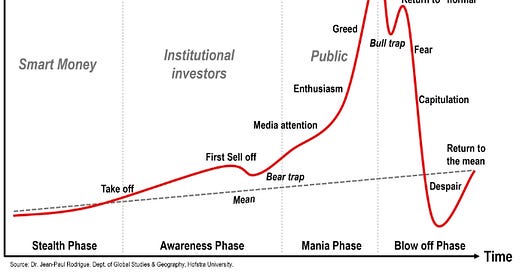I think most people are probably familiar with this decades-old illustration of the stages of a bubble….
The stages of a stock market bubble, often associated with speculative frenzies and irrational exuberance, are typically described as follows: stealth, awareness, mania, and blowoff. These stages represent the progression of investor sentiment and behavior during a market bubble, as prescribed by human nature.
Stealth Stage:
During the stealth stage, there is little public attention or awareness of the asset or market in question. Prices may start to rise due to fundamental factors or early speculation, but the general public and mainstream media have not yet caught on.
Smart money and early investors might be accumulating positions in the asset, recognizing its potential before the broader market does.
The lack of widespread attention often means that valuations remain relatively reasonable, and the bubble has not yet formed.
Awareness Stage:
In the awareness stage, news about the asset or market begins to spread, and public awareness increases. This can happen through media coverage, social media, or word-of-mouth.
Prices start to rise more rapidly as more investors become interested, and the early gains attract attention from both retail and institutional investors.
During this stage, the asset may still be seen as having strong growth potential, and valuations may rise significantly.
Mania Stage:
The mania stage is characterized by a frenzied rush of speculative buying. Investors, driven by fear of missing out (FOMO), jump into the market en masse.
Prices skyrocket, often detached from underlying fundamentals or rational valuation metrics. Investors may disregard risks and believe that prices will only continue to rise.
The mania stage can be marked by excessive optimism, widespread speculation, and euphoria. This is when the bubble is at its peak and most vulnerable to a correction.
Blowoff Stage:
The blowoff stage marks the climax of the bubble. Prices reach unsustainable levels, and there is extreme overvaluation.
Many investors who entered during the mania stage start to realize that the bubble is unsustainable and begin selling their positions.
This stage often ends abruptly with a sharp and severe market correction or crash. Prices can plummet rapidly as panic selling ensues, leading to significant losses for those who bought in at the peak.
The blowoff stage can result in a significant market downturn, and it may take a long time for prices to recover and stabilize.
It's important to note that not all asset bubbles follow this exact sequence, and the timing and intensity of each stage can vary. Additionally, not all bubbles end in a blowoff stage; some may experience a gradual deflation of prices over time. But in this case, the stock market is following this formula almost precisely so far. Thus what comes next is very predictable.





